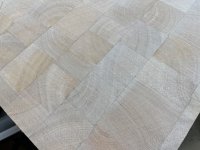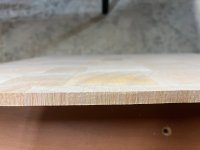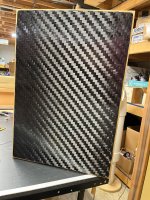If you are also interested in Oliver Göbel's patent, here it is. And the link to his website.thanks thanks
I have experimented with carbon and honeycomb for a total thickness of about 4mm, very similar to Tectonic. Obviously, the exciters are not the same, and I have never heard the Tectonic ones, but I have formed an idea. Before proceeding, I keep asking myself if it’s worth it. It has a particular and even pleasant sound, but the flaws seem unsolvable. Unfortunately, their extension in the lower and especially in the upper range is a major limitation, along with the maximum power of the exciters and the membrane. I believe the exciter part might be a minor issue compared to figuring out the right membrane formula. I like the enthusiasm I find in the forum, but continuing to formulate theories that can’t be easily tested makes the operation impossible. Sure, one can settle for it, but nothing more."
Let me know if you need any adjustments!
Let me know if you need any adjustments!
You have to love that the information provided by DPK to the reviewer was almost word for word that same as what H. Azima wrote about 25 years ago here:Here it is.
As with most reviews, whether paid or otherwise, what is shown is not always what is meant to be seen, often accompanied by some misdirections. Translations also contribute to that dilemma.
https://vxm.com/NXT.html
From the Azima article:
From the description Tefra/DPK provided to the reviewer:
Aren't you at least supposed to put it in your own words?!?
Eric
The balsa he's using is called "end grain" balsa. It's actually rather unusual in that the direction of the grain is through the thickness of the panel, rather than parallel to length or width of the panel. Pics below show a thick piece I have around. In the second image you can see how the grain lines are pointed through the thickness of the panel. Unfortunately, it's hard to find (for me at least!) a source end grain balsa that is thin enough for a DML panel like Goebel's.If you take a careful look at that membrane, you’ll notice that it is made of equal pieces of very thin balsa glued together at the thin side, with the pieces arranged against each other in the manner that carpenters typically glue wood together, with the grains placed against one another.
So the balsa core panels I've made (with both fiberglass and carbon fiber skins), all used the more common balsa sheets, where the grain runs parallel to the long direction of the sheet. Third image shows a carbon fiber version. Of course, Goebel's later panel also used carbon fiber, in place of the fiberglass used in the original Goebel speaker, and shown in the video lekha linked.
Eric



Christian,I have to explain that I made a set of measurements of 30x40cm DML with different back load, a 8cm large range in an open baffle of same dimension and the same model in a small closed box. The peak is here for the DML and the open baffle with or without a back load (even if it is less with) but not (or very small) with the small closed box. A difference being the front face of the closed box is maybe 10x12cm (and 10cm depth 1.2l).
Sorry but I am having a hard time following this description. Can you try to clarify?
Eric
The extension in the lower range is relatively easy, assuming you are not expecting too much. What are you hoping for? I think 80 Hz or thereabouts is reasonable to expect.Unfortunately, their extension in the lower and especially in the upper range is a major limitation, along with the maximum power of the exciters and the membrane.
Getting good low end really depends on two things: (1) having a large enough panel, and (2) using a frame and double side foam tape or similar to support the panel around all (or most) of the perimeter.
What thickness (or weight) of carbon fiber have you used? A 4mm core will create a very stiff panel that might need to be pretty large, unless the carbon skins are very thin.
Eric
As with most reviews, whether paid or otherwise, what is shown is not always what is meant to be seen, often accompanied by some misdirections.Aren't you at least supposed to put it in your own words?!?
Anyway, One can always give them a ring and ask. The contact details are available in Tefra Audio website.
Whatever balsa he used doesn't really matter; what is important is the holes at regular intervals (fig. 6 of his patent) — "shows a perforated grid plate, preferably made of medium-density fibre material, which has openings of a certain diameter and predefined hole spacing, and which is positioned at a specific distance from the panel." All patents have misdirections. The holes are in the panel itself, not at a specific distance from the panel.The balsa he's using is called "end grain" balsa. It's actually rather unusual in that the direction of the grain is through the thickness of the panel, rather than parallel to length or width of the panel.
"a certain diameter and predefined hole spacing"... There is no further mention of them anywhere else.
Last edited:
Actually it may. The elastic properties, especially the shear moduli, depend greatly on the direction of the grain relative to the deformation. So the orientation of the balsa may influence the coincidence frequency in each of the directions, and hence whether or not there are off-axis peaks at audible frequencies. I wish I could get end grain balsa to see if it really matters or not.Whatever balsa he used doesn't really matter;
I think you are confused here. Yes, the panel itself (well, at least the balsa core) does indeed have holes at regular intervals, but those are not the "openings of a certain diameter..." The holes in the balsa, seen in the image below, have to to with the manufacturing method of the fiberglass/balsa composite panel. He is using vacuum infusion of the epoxy resin into the fiberglass material which covers both faces of the balsa core panel. The holes in the balsa allow the epoxy resin to freely flow from one side of the panel (where the epoxy is fed) to the other side (where the vacuum is drawing the epoxy in), to make sure that all the fiberglass is fully wetted with epoxy. In the end, there really are no longer any holes in the panel, as they are filled with epoxy. It just looks like holes because the epoxy and the fiberglass are all transparent, once the epoxy is fully infused into the fiberglass fabric. You won't seem them in his carbon fiber panels. They are likely still there, you just can't see them because carbon fiber isn't transparent like fiberglass.what is important is the holes at regular intervals (fig. 6 of his patent) — "shows a perforated grid plate, preferably made of medium-density fibre material, which has openings of a certain diameter and predefined hole spacing, and which is positioned at a specific distance from the panel." All patents have misdirections. The holes are in the panel itself, not at a specific distance from the panel.
But what he is referring to as the "perforated grid plate....which has openings" is a different thing, which he explains in the clip below. He is clearly talking about a separate cover plate (with round or rectangular apertures) to manage the rear radiation.
And mentions again in the claims:
Eric
Goebel mentions the "concentric aperture in a covering" here too, at the beginning of his patent.

Eric
Eric
All patents contain misdirections. However, when the designer creates an advertising video, they often overlook this. You should listen or read the transcript. It is standard practice to never divulge too much in a patent.🙂I think you are confused here. Yes, the panel itself (well, at least the balsa core) does indeed have holes at regular intervals, but those are not the "openings of a certain diameter..."
View attachment 1393264
For consideration ...

Doesn't matter, who wrote the patent. You have to click on the image to enlarge it for reading.
Doesn't matter, who wrote the patent. You have to click on the image to enlarge it for reading.
My Deutsche is weak, and I didn't see an otion for English subtitles. But please tell me where in the video it says they have holes in the finished panels.All patents contain misdirections. However, when the designer creates an advertising video, they often overlook this. You should listen or read the transcript. It is standard practice to never divulge too much in a patent.🙂
Eric
In my Youtube video, there is an option for subtitles. I don't know German too.I didn't see an otion for English subtitles
lekha,
Your point this time being what? That you can make **** speakers by tearing apart regular drivers, sticking some wand on it an pressing it against random trash? Revolutionary! Inspiring! Thanks.
Eric
Your point this time being what? That you can make **** speakers by tearing apart regular drivers, sticking some wand on it an pressing it against random trash? Revolutionary! Inspiring! Thanks.
Eric
One of the reasons, I didn't give the link to that patent. I have no interest in arguing.
Here's a new player in the DML groundbreaking market. Have a go at them. 😉
Here's a new player in the DML groundbreaking market. Have a go at them. 😉
Likewise. But we all make mistakes. So if someone misunderstands, and someone else corrects them, that is a good thing, right?I have no interest in arguing.
Eric
Denny Mayer 4 years ago...Likewise. But we all make mistakes. So if someone misunderstands, and someone else corrects them, that is a good thing, right?
Eric
Denny Mayer 5 months ago,
Tectonics seems to be defunct; the chap is still around with a new company, but using the same speaker, and with stuffing at the back. The other chap, known for hanging-the-panels-by-strings, still seemed to be active about a year ago. A new chap seems to be active, at least on his website and on YouTube. However, no one is leaving any comments on his videos. A product from a well-known manufacturer is being discussed by a Frenchman. The intriguing fact is that there seem to be no visitors. Excerpts from a six-year-old patent (valid until 2038), now assigned to a German automotive company shown here, take it or leave it. You can bet that people are trying, but the interest in DMLs is in its final throes.
Well, considering the "exciter," it is merely a standard speaker driver, but without the cone and the basket, and featuring a much stiffer spider. The concept of transmitting sound through a panel with tiny holes has been around for a long time. There have also been some patents related to it, though I can't recall which ones at the moment. Some of those ideas are utilised by established speaker manufacturers, without disclosing the reasons for their presence.
Why to spend energy and time in such a flow of patents, links (fortunately some are interesting) no global analysis or synthesis but riddles and mis-interpretations? Where does it leads to except disorder, waste of energy in unanswered questions or to correct incorrect the mis-interpretations?
Christian
Christian
- Home
- Loudspeakers
- Full Range
- A Study of DMLs as a Full Range Speaker